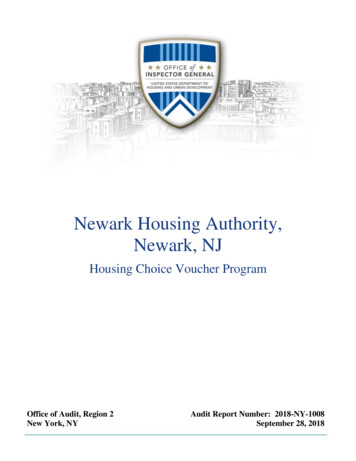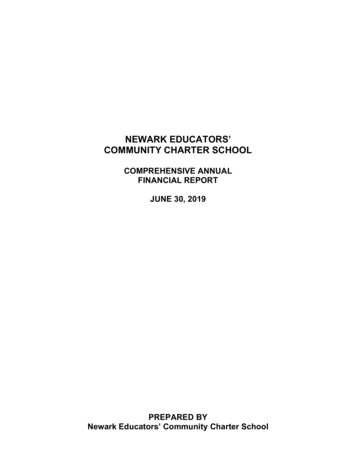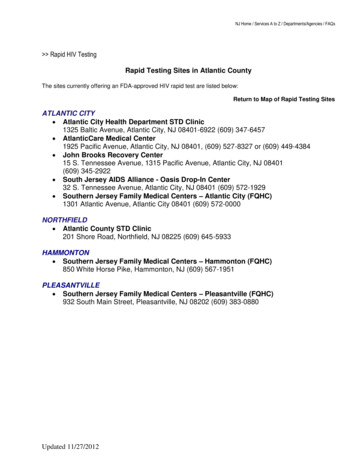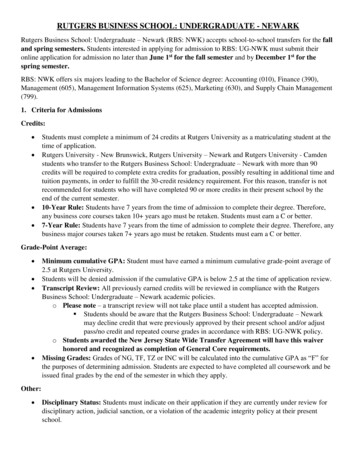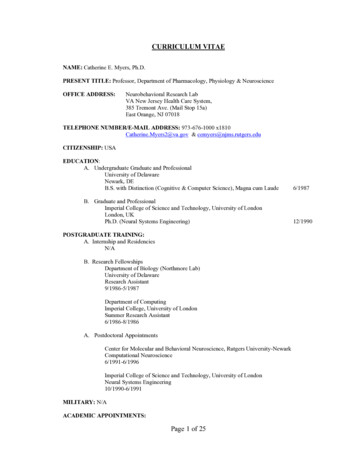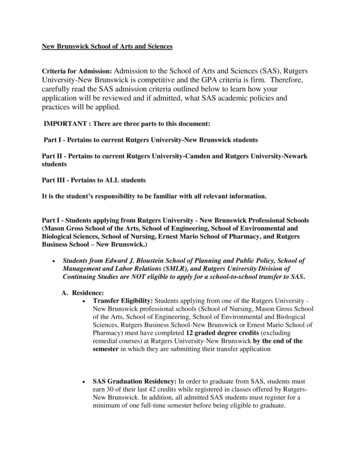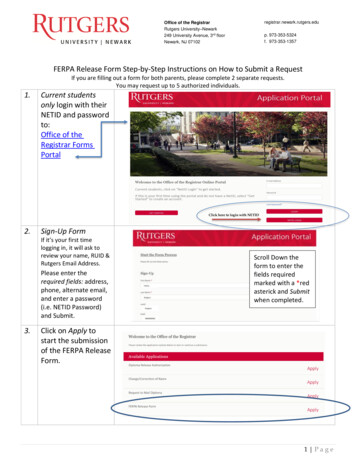
Transcription
The Institute for Health, Health Care Policy, and Aging ResearchEvaluation of the Newark School-BasedYouth Services ProgramPart II: Report on Clinic Enrollmentand Utilization, Academic Performance,and Teacher PerceptionsMina Silberberg, Ph.D.Jonathan Huston-Wong, Psy.M.Kimberley Fox, M.P.AJoel C. Cantor, Sc.D.June 2003
ivRutgers Center for State Health Policy, June 2003
AcknowledgementsThis study was conducted under contract to Children's Hospital of New Jersey atBeth Israel Medical Center (part of Saint Barnabas Healthcare System) with funding fromthe Healthcare Foundation of New Jersey. The views expressed in this report are solelythose of the authors and do not necessarily reflect those of Children's Hospital, SaintBarnabas Healthcare System, or the Healthcare Foundation of New Jersey. We thankChildren's Hospital, the Healthcare Foundation of New Jersey, the Newark SchoolDistrict, clinic and school staff, and participating parents for the many ways in which theyhave supported and facilitated this research. Specifically, we would like to thank GerryGoodrich of Saint Barnabas Health Care System; Patricia Caroll and Rose Smith fromChildren's Hospital; Armando Medina, Hope Blackwell, Jack Duggan, and RosemarieKopasci from the Newark School District for assistance in obtaining data and workingwith the Newark schools; and Gloria Blount for providing useful information on how thedata are collected and interpreted. We also appreciate the principals, staff, and teachersof our six study schools whose efforts facilitated our survey. Finally, we wish toacknowledge the contributions of Yamalis Diaz, Bari Erlichson, Dorothy Gaboda, ElenaGoldman, Paul Hamborg, Patricia Hurley, Mario Kravanja, Judy Pollacheck, FelicityTsikiwa, and the staff of Rutgers Center for State Health Policy.This report is one in a series commissioned by the Healthcare Foundation ofNew Jersey. Others are available at www.cshp.rutgers.edu:Silberberg, M, Fox, K, Quinn, W, and Cantor, J. Evaluation of the NewarkSchool-Based Youth Services Program, Part One: Report of StakeholderPerceptions. Rutgers Center for State Health Policy, July 2000.Silberberg, M and Cantor, J. Creating Sustainable School-Based Health Centers:A Report on Clinic Financing. Rutgers Center for State Health Policy,September 2002.vNewark School-Based Youth Services Evaluation Part II
viRutgers Center for State Health Policy, June 2003
Table of ContentsExecutive Summary.ixIntroduction .1Program Background.2Overall Evaluation Design.3School Clinic Enrollment and Utilization .4Backgrounds and Methods.5Findings: Enrollment and Utilization .6Academic Performance .23Background and Methods.23Findings: Academic Performance .24Teacher Perceptions.25Background and Methods.25Findings: Teacher Perceptions .26Conclusions and Recommendations .36Clinic Operations and Impact .36Future Clinic Monitoring and Evaluation .39Endnotes .43References .45Appendix A: Teacher Survey (Clinic Version).47Appendix B: Teacher Survey (Non-Clinic Version) .61TABLES AND FIGURESTablesTable 1: Comparison of Children Registered in Clinics with School Enrollmentby Grade, Gender, and Race/Ethnicity.8Table 2: Usual Source of Care and Type of Insurance Among Students Registeredat a Clinic.10Table 3: Pre-existing Conditions/Health Problems Reported by Students atTime of Registration.12Table 4: Percentage of Children Using Clinics Among Those Registered.13Table 5: Percentage of Registered Children Using Clinics byStudent Characteristics.14Table 6: Users of Clinics as Percentage of Students Registered byPre-Existing Health Condition .15vNewark School-Based Youth Services Evaluation Part II
Table 7: Number of Visits per Child Using the Clinic Services.16Table 8: Percent Frequent Users by User Characteristics .18Table 9: Conditions Identified for Total Visits and for Visits by Frequent Users.19Table 10: Average Number of Visits to Clinic per Month by Season, School,and Provider Type .20Table 11: Nurse Practitioner and Social Worker Clinic Visits by Procedure. 23Table 12: Clinic and Non-clinic Respondents' Teaching Experiencesand Responsibilities .27Table 13: Prevalence of Health Conditions Among Students (Per 1,000 Students).28Table 14: Incidence of Classroom Health Episodes this School Year(Per 1,000 students).28Table 15: Teacher Responses to Classroom Health Episodes.30Table 16: Teacher Ratings of School Services Available for Addressing StudentHealth Issues .31Table 17: Additional Use of School Health Services by Respondents .32Table 18: Clinic Teachers' Ratings of Colleagues' Familiarity with SchoolClinic Services.33Table 19: Clinic Teachers' Ratings of School Clinics.34Table 20: Clinic Teachers' Average Ratings for Prospective Changes toSchool Clinics .35FiguresFigure 1: Percent Clinic-Registered Students vs. All Students Enrolled in Schoolin Each Grade.9Figure 2: Number of Visits to Clinics Each Quarter.21viRutgers Center for State Health Policy, June 2003
Evaluation of the Newark School-Based Youth ServicesProgram Part II: Report on Health Clinic, SchoolPerformance, and Teacher Survey DataMina Silberberg, Ph.D.; Jonathan Huston-Wong, Psy.M.; Kimberley Fox, M.P.A.;Joel C. Cantor, Sc.D.EXECUTIVE SUMMARYIntroductionIn April of 2000, the Center for State Health Policy at Rutgers began a two-stageevaluation of three school-based health clinics in Newark, New Jersey. These clinicsoperate at the George Washington Carver, Dayton St., and Quitman St. Schools. Theclinic program is funded by the Healthcare Foundation of New Jersey and operated byChildren's Hospital of New Jersey at Newark Beth Israel Medical Center, with thecooperation of the Newark School District. This report documents the results of thesecond and final stage of the clinic program evaluation.Research Questions and MethodsThe purposes of the evaluation were to: 1) Establish quantitative measures ofclinic clients and services, student health needs, and teacher use of and attitudes towardsthe clinics. 2) Identify trends, strengths, and concerns. 3) Identify weaknesses in clinicdata for self-evaluation and managed care contracting. 4) Explore the impact of a clinicpresence on schools. 5) Assess whether clinic impact can be observed in currentlyavailable data on academic behavior and performance. 6) Assess the potential of suchdata for future evaluations.The following three methods were used to address these topics: 1) Assessment ofarchived clinic data for the three clinics for the period Fall 1998-Spring 2000. 2) Assessment ofstandardized test scores and absenteeism rates for the three clinic schools and threematched comparison schools for the same period. 3) Creation, administration, andanalysis of a survey of teachers at the three clinic and three comparison schools. Thethree comparison schools are the Louise A. Spencer, Cleveland, and Miller St. Schools.viiNewark School-Based Youth Services Evaluation Part II
Key FindingsThe clinics have achieved high levels of use among students, as measured both byparental consent rates and percent of registered students using the clinic. Clinic use hascontinued to grow; however, more can still be done to fully utilize clinic capacity andenhance clinic-school integration. The clinics appear to be addressing student's keyhealth needs, and the way teachers perceive and handle student's physical and dentalproblems, as well as the overall health education in the school. Teachers in clinic schoolsexpress a high level of confidence in school resources for medical, dental, andsocial/behavioral health.We recommend ways to support the clinics' continued growth, particularlycollaboration with school staff to identify how clinics and schools can most effectivelysupport each other's work to achieve their common goals. Social/behavioral health is aparticular area of concern for teachers, and an area where clinic potential may not befully realized.Existing clinic and academic data are inadequate for assessing how the clinics areaffecting student health or academic performance. There are a number of signficantshortcomings of these data for evaluating student outcomes, and we recommend ways toimprove these data. We cannot eliminate the possibility that the clinics have nomeasurable impact on student health or academic outcomes. Studies of other clinicprograms have found few impacts on these types of measures. Moreover, the Newarkclinics are relatively new, and it may take time for them to influence student outcomes.The evaluation does provide evidence that the clinics have improved access to care andacademic life at the schools: The evaluation provides ample evidence of significant health needs at theschools, and the design of the clinics is well matched to these needs. By national standards, the clinics have attained very high parental consentrates, and a high proportion of registered students has visited the clinics. The clinics are respected by, and inspire confidence among, teachers.Specifically, the clinics seem to have positively affected the way teachershandle students' physical and dental problems; and teacher confidence inoverall school resources for dealing with medical, dental, andsocial/behavioral problems is higher in clinic schools than in comparisonschools.viiiRutgers Center for State Health Policy, June 2003
The evaluation also identified areas that should be examined more closely orwhere improvements may be warranted: Attendance and test score data do not reflect an influence of the clinics.As noted, these data, which are drawn from routine school records, maynot provide adequate measures of clinic impact. The level of clinic activities addressing social and behavioral healthproblems does not appear to match the substantial teacher concernsabout these issues. Although the overall volume of visits to clinic providers has risen since theclinics opened, the number of visits per day appears to be leveling off at avolume well below the capacity of the clinics. The clinics have a reasonable comprehensive database reflecting studentenrollment and utilization, but these data are not adequate for ongoingprogram evaluation or for contracting with managed care organizations.RecommendationsEnhancing the Clinic ProgramImprove clinic integration into the schools, and revisit clinic activities and staffing: Emphasize collaboration among clinic program and on-site staff, schooladministrators, guidance counselors, and teachers to define the best waysthat clinics can serve the schools and that schools can support clinicservices. Continue to explore innovative approaches, such as the clinicprogram's current efforts to provide continuing education creditsfor teachers. Continue efforts to increase teacher awareness of all clinic services. Monitor the number of visits made to the clinics over time. Bringstakeholders to the table to discuss trends, daily use rates, and capacity.Assess current staffing model and clinic activities. Consider the likelihood for successful collaborative relationships whenselecting schools.ixNewark School-Based Youth Services Evaluation Part II
Enhancing Clinic Data Collection for Evaluation and ManagementBring stakeholders together to define the most critical data needs and focusefforts on improving data collection for those fields. Specific proposals for improvementof data collection and recording are: Add a discharge/transfer date to the archived clinic data for children nolonger in the school. Add the response option "refused to state" or "not provided" to theinsurance status, insurance type, and insurance company fields andemphasize entering a response for each record. Consider adding these options to other fields (e.g., student risk factors)as needed. Have clinic and program staff review insurance type options and agree onthe distinctions among them. Consider adding fields to track changes in insurance status and othercritical indicators over time. Bring clinic and program staff together to review and agree upon thedefinition of a visit. Consider whether clinics should keep track of time spent on otheractivities - such as case management or classroom-based health education.Assess whether this can be done without excessive burden to staff. Consider regular feedback of data to the clinicians and the administrativeassistants in report form. This will help them improve services, increasethe perceived value of the data, and clarify which data are most important. Bring clinic and program staff together periodically to revisit datacollection needs and challenges, facilitate problem-solving, and ensureconsistency in data collection.Enhancing Data to Assess Academic PerformanceMake changes to the academic data that are collected and compiled: Compile existing statistics on student tardiness and leaving school. Record and compile reasons why children leave school. Monitor changes taking place in student testing and, as these testsdevelop, assess their utility for providing clinic outcome measures.xRutgers Center for State Health Policy, June 2003
Create tools that provide information about the pathways presumed toconnect clinic use to academic behavior and performance, e.g., a teachersurvey similar to the one used for this evaluation. Consider use of studentsurvey. When possible, conduct baseline surveys before establishment ofa clinic.xiNewark School-Based Youth Services Evaluation Part II
xivRutgers Center for State Health Policy, June 2003
Evaluation of the Newark School-Based Youth ServicesProgram Part II: Report on Health Clinic, SchoolPerformance, and Teacher Survey DataMina Silberberg, Ph.D.; Jonathan Huston-Wong, Psy.M.; Kimberley Fox, M.P.A.;Joel C. Cantor, Sc.D.IntroductionIn April of 2000, the Rutgers Center for State Health Policy began a two-stageevaluation of three school-based health clinics in Newark, New Jersey. The clinicprogram was established in 1997 through a partnership between the HealthcareFoundation of New Jersey (the clinic funder), Children's Hospital of New Jersey atNewark Beth Israel Medical Center (part of the Saint Barnabas Healthcare System andthe clinic sponsor), and the Newark Public School System. In June of 2000, CSHPpresented a report on the first stage of the evaluation - an analysis of stakeholder insightsinto the implementation of the clinic program and perceptions of program operations,clinic services, and results (Silberberg, Fox, Quinn, & Cantor, 2000). The current reportdocuments the results of the second stage of the evaluation.This stage of the evaluation had three components: 1) Analysis of clinicenrollment and utilization data for the academic years 1998/1999 and 1999/2000.2) Assessment of school attendance and standardized test score data for the same yearsfor the three schools with clinics and three matched comparison schools. 3) Results of aconfidential survey of teachers on the classroom impact of student health issues andclinic access.The purposes of the evaluation were the following:1.Develop quantitative measures of clinic participation and services,student health needs, and teacher use of, and attitudes toward, theclinics.2.Apply these indicators to identify trends in clinic activities and areas ofstrength and concern.3.Identify ways to enhance the utility of the clinic data system for theongoing assessment and management of clinic operations.1Newark School-Based Youth Services Evaluation Part II
4.Assess the impact of the clinics on how teachers address student healthneeds and assess the adequacy of school health resources.5.Explore the potential to use academic behavior and performance data toevaluate the clinics' educational impact.This section provides background to the current study, and briefly describes theclinics and the schools in which they are located (a more detailed description is providedin Silberberg et al., 2000) as well as the overall research design. The subsequent sectionsprovide the results of the three evaluation components, and include further informationon the data and the specific methods employed for each. Finally, we conclude withrecommendations for the clinic program, including suggestions for future data collection.Program BackgroundIn 1997, the Healthcare Foundation of New Jersey, in partnership with the NewarkSchool District and the Saint Barnabas Health Care System, began working to establishhealth clinics in the Newark schools through the School-Based Youth Services Program.School-based health clinics, increasingly prevalent nationwide, aim to providecomprehensive primary care services to school children. The three Newark clinicsoriginally funded by the Foundation were established in three elementary/middle schools:the George Washington Carver School, the Quitman St. School, and the Dayton St.School. Although the clinic program continues to grow, this report assesses the clinics atthe three original schools, where the clinics have had time to establish themselves and forwhich historical data are available.Clinic services at the participating Newark schools are free to all students whoseparents or guardians have signed a consent form; in this report, we describe thosestudents as "registered" to use the clinics. Each clinic has a full-time pediatric nursepractitioner, social worker, and administrative assistant. The school nurse, whilemaintaining her traditional duties, is also an integral part of the clinic team, triagingstudents who need medical care. Mental and dental health services may be accesseddirectly. The nurse practitioners provide primary and preventive health services—physical exams, follow-up medical care, treatment of minor illnesses, chronic caremanagement, immunizations, and nutritional counseling. Social work services includeindividual, family, and group counseling and crisis intervention. A dental team fromChildren's Hospital visits the clinics on a more than half-time basis, providingexaminations, x-rays, cleanings, fluoride treatments, and dental sealants. Referrals for2Rutgers Center for State Health Policy, June 2003
outside care are made in all three clinical areas - medical, social/emotional, and dental and free follow-up dental care is provided for clinic participants at Beth Israel MedicalCenter. Clinic participants also receive free prescription medications. In addition, clinicstaff provide health education in classes, health fairs, and other venues; each year adental hygienist makes a 30-minute presentation to every class in each school.Administrative and clinical support and oversight is provided to the clinics byChildren's Hospital through a program director, three physicians, a psychiatrist, and adentist. In addition, the administrative assistant at the Quitman St. School supervises theassistants at the other two locations, and the school district provides technical assistancewith data collection.The first clinic was opened in February 1998 at the George Washington CarverSchool, a kindergarten through eighth grade (K-8) school near Beth Israel Medical Center,that includes the Bruce St. School for the Deaf. The second opened at the Quitman St.School in June 1999, although during the 1998/1999 school year the social worker wasseeing students and efforts were begun to obtain parental consents. Funding for thisclinic is also provided by the Prudential Foundation, which was already supportingcommunity school programs. While the Quitman St. School originally served pre-K-8, itwas changed to pre-K-4 for the 1999/2000 school year. The nearby Morton St. School nowserves the middle school population (5th through 8th grades), and an arrangement wasestablished in the fall of 1999 for Morton St. students to use the Quitman clinic, primarilyfor dental and urgent care. Quitman St. also includes the Berliner School for specialneeds students. Finally, in June 1999, after a partial start-up in the 1998/1999 school year(providing dental care and part-time social work services), a clinic became fullyoperational at the Dayton St. School, serving K-8.Overall Evaluation DesignThe procedures employed in this study were reviewed and approved by theRutgers University Institutional Review Board for the Protection of Human Subjects. Forthe purposes of this evaluation, comparison schools were identified for each of the threeclinic schools. Selection was based on similarity to clinic schools on the dimensions oflocation, grade levels, size, and racial/ethnic composition. Based on the first stage of theevaluation, we understood these contextual factors to be potentially related to studentaccess to health services, health needs, use of health services, and academicperformance. Comparison schools fitting our criteria were identified by Rosemarie3Newark School-Based Youth Services Evaluation Part II
Kopacsi, Research Supervisor at the Newark Public Schools Office of Planning,Evaluation, and Testing. The Carver School was matched with the Louise A. SpencerSchool, the Quitman St. School with the Cleveland School, and the Dayton St. School withthe Miller St. School.The school district provided us with clinic and academic data for the academicyears 1998/1999 and 1999/2000. These are the two years in which all three clinics wereoperational. However, our data analysis is attentive to the fact that only the clinic atGeorge Washington Carver was fully operational in both academic years and had in factopened in the spring semester 1998. Although we had hoped to contextualize ourassessment of the academic data with trend information from a period prior to clinicimplementation, changes in standardized testing made the testing data from 1998/1999and 1999/2000 non-comparable to that from earlier years.School Clinic Enrollment and UtilizationIn this section we analyze data maintained by the school clinics to address thefollowing questions about clinic clients and activities:1. How many students are registered at the clinics?2. How does the composition of registered students compare with theschool populations? Are any groups underrepresented?3. What are the health needs of registered children?a. Do they have access to health care in the community?b. What is the prevalence of pre-existing health problems amongthese children?4. Of those children registered for the clinics, how many have ever usedclinic services?5. What are the characteristics of children who use the clinics comparedto those registered overall? Are needy students usingthe clinics?6. How many visits do children make to the clinics, on average?7. What are the characteristics of frequent clinic users and how do theycompare with users overall?8. What health conditions are treated in the clinics? Are the conditions offrequent users different than those of users overall?4Rutgers Center for State Health Policy, June 2003
9. What is the volume of services provided by the clinics andindividual providers?10. What are the types of services provided by the clinics?Background and MethodsAll three clinics collect information on a uniform database called SchoolHealthCare ONLINE!!! (SHO!!!), which was designed by David Kaplan for the specificpurpose of evaluating school-based health centers (Kaplan, 1995). The data analyzed forthis report from 1998/1999 and 1999/2000 were collected through the original SHO!!!system. In 2001, the clinics upgraded from a DOS-based to a Windows-based version ofthe SHO!!! data system called Clinical Fusion (Kaplan, 1999). Most of the same datacontinue to be collected in the new database, so recommendations regarding data qualityimprovement are still valid.In the SHO!!! database, each of the three clinics collects data on the childrenenrolled and receiving services as well as the nature of the visits made to eachpractitioner. The clinics have both an active file and archived data for past years. Theanalysis presented here is based on the archived data.Patient information is gathered from an initial parental consent form, which asksthe parent or guardian to provide the child's grade, date of birth, gender, medical historyincluding pre-existing conditions, insurance coverage, and the family doctor or otherusual source of care. When a child visits the clinic, additional information is gatheredincluding race/ethnicity, risk factors identified by a provider, and how the child wasreferred to the clinic. Data gathered from registration consent forms may be updated ifnew information is acquired in the course of discussing the child's condition with theparent. When the record is updated, the new information replaces any existing data, sothere are no historical data to assess how information is discovered over time or thesource of information.In addition to information on the clients, the clinic records data on the servicesprovided. For each clinic visit, the database includes the date of the visit, the child'spresenting diagnosis and any other diagnoses identified in the course of examination, theprocedure performed, the time spent with the patient, medications dispensed orprescribed, referrals made, and follow-up information. In analyzing the data, we foundthat the time spent with the patient was not uniformly reported and sometimes conflicted5Newark School-Based Youth Services Evaluation Part II
with the time indicated on procedure codes, so we did not analyze this data. Similarly, thedata reported on referrals, follow-up and prescriptions, and children's health risks wereinconsistently reported and difficult to interpret and thus are not discussed here. In the2001 update version of the clinic data system—Clinical Fusion—the health risk fieldswere removed for this same reason.To make comparisons across schools, we assumed a certain level of consistencyin data collection and reporting across clinics. All three clinics use standardized datacollection forms. However, data collection may vary among or within schools. Forexample, one school may rely primarily on the parents filling out the consent form, whileanother may generally fill the form out with them. Different clinicians may approach visitcoding differently. Where possible, we will identify unusual discrepancies across clinics.Findings: Enrollment and UtilizationHow Many Students are Registered in the Clinics?As reported in our first evaluation, according to clinic staff the rates of parentalconsent to register children in the clinics are high. As of May 2000, staff reported that theclinics had registered 98% of students at Dayton, 92% of students at Quitman, and 72% ofstudents at Carver. (The Carver clinic staff reported that their registration rates were lowbecause of deficiencies in the school enrollment records resulting from the highly mobilestudent population.) These are very high registration rates, as compar
Tsikiwa, and the staff of Rutgers Center for State Health Policy. This report is one in a series commissioned by the Healthcare Foundation of New Jersey. Others are available at www.cshp.rutgers.edu: Silberberg, M, Fox, K, Quinn, W, and Cantor, J. Evaluation of the Newark School-Based Youth Services Program, Part One: Report of Stakeholder


